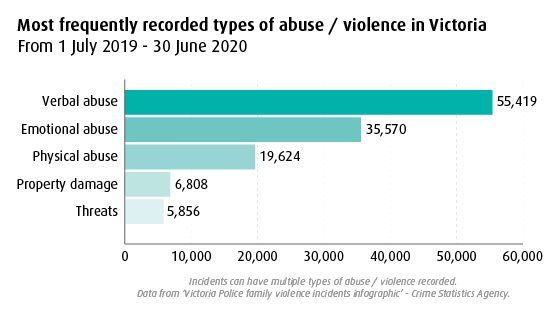59,798 Victorians were directly affected by family violence in FY2019-2020¹.
Sadly, family violence affects one in five women in Victoria over the course of their lifetime², and experts tell us that COVID-19 has exacerbated incidences of family violence across our state.
But while statistics tell us that most people affected by family violence are women, it’s important to know that men and children are affected, too.
In 2019-2020, 42,946 females were affected by family violence (71.8% of total impacted), and 16,852 males were affected by family violence (28.2% of total impacted)¹.
2020-21 UPDATE: 62,653 Victorians were directly affected by family violence, including 44,768 females and 17,885 males¹.
So what does family violence look like? And what can we do about it?

What might come as somewhat of a surprise is that family violence isn’t only perpetrated by current or former partners.
Other people who perpetrate family violence can include parents, children, and other family members.
Affected family members can also be impacted in several ways.
For instance, a family member may experience family violence towards themselves, or they may witness family violence to another family member, or they may not experience or witness family violence at all, but are indirectly impacted because their caregiver has been directly impacted by family violence.
In 2019-2020, family violence statistics show us that¹:
- 32.0% of affected family members were current partners
- 30.2% were former partners
- 16.8% were parents of aggressors
- 7.9% were children of aggressors
- 12.9% were other family members
Unfortunately many women who have been affected by family violence do not seek help – in fact, of the women who have experienced family violence in Victoria, 46% did not seek advice or support, and 82% had never contacted the police⁵.
What is family violence?
Family violence isn’t just physical - it can be emotional, financial or social too.
The Victorian Department of Justice and Community Safety states that “family violence includes harmful or violent behaviour that is used to control, threaten, force or dominate a family member through fear”.
Family violence can include hitting or pushing; sexual abuse; emotional abuse such as humiliation, threats or insults; financial abuse, such as removing access to money for food and clothes; damage to property; threatening to harm other family members or pets; or stopping someone from seeing their friends and family.

Understanding the signs
Knowing the signs of family violence can not only save someone from long-lasting trauma, but it can save a life.
Common signs of family violence that you may recognise in affected family or friends can include³:
- Controlling behaviour from the aggressor
- Being afraid of the family member/aggressor
- Seeming anxious to please the family member/aggressor
- Family member (aggressor) makes all the decisions
- Being afraid to be at home with the family member/aggressor
How to support someone who may be experiencing family violence
The first recommended step in supporting someone is first to speak to them about your concerns.
It’s important to approach the topic gently, and to be aware that the person may become defensive once you bring up the topic.
Beyond Blue recommends using statements that start with “I” so that it shows your concern and sounds less like an opinion or a statement – for example, “I’m wondering if everything is okay at home?”.
If the person doesn’t want to chat, let them know you’re there if they want to talk later, and keep a look out for signs that they would like to have a chat.
But if they do want to chat, make sure you’re prepared to listen and ensure you make an effort to keep in contact with them regularly, so that they know you’re there to support them.
You might also like to recommend where they can find professional support, and you could help the person to create a safety plan.
It’s really important to look after your own mental health and wellbeing too, because dealing with family violence matters can be stressful, frustrating and frightening – and we can’t offer our best support when we ourselves are struggling.
What to avoid when offering support:
- Avoid pushing for information – people who experience family violence may not realise they’re a victim, and so if you imply that they are one, they may become defensive. Your role is to be a listening ear and to guide the person to find professional help if and when they want it.
- Avoid giving advice or telling them what you would or wouldn’t do – give helpful information instead.
- Avoid making them feel like they’re the problem – someone affected by family violence is less likely to seek help if they’re made to feel like it’s their fault. It’s not your role to figure out the reasons behind family violence or to give your opinion, what’s important is they find the support they need with your help.
- Avoid criticising the aggressor/family member – this could trigger a defensive reaction, particularly if the person doesn’t feel like they’re a victim or if they’re scared of the aggressor.
- Most importantly – don’t give up! Some people leave and then return to an abusive relationship for a variety of reasons, but this doesn’t mean that they’re safe or that they don’t need help.
Where to find help:
At CatholicCare Victoria we also offer a range of supports for people who have experienced or are experiencing family violence:
Integrated Family ServicesSpecialist Family ViolenceCounsellingCentacare Housing ServicesEmergency ReliefVictims Assistance Program
References:
Read more: